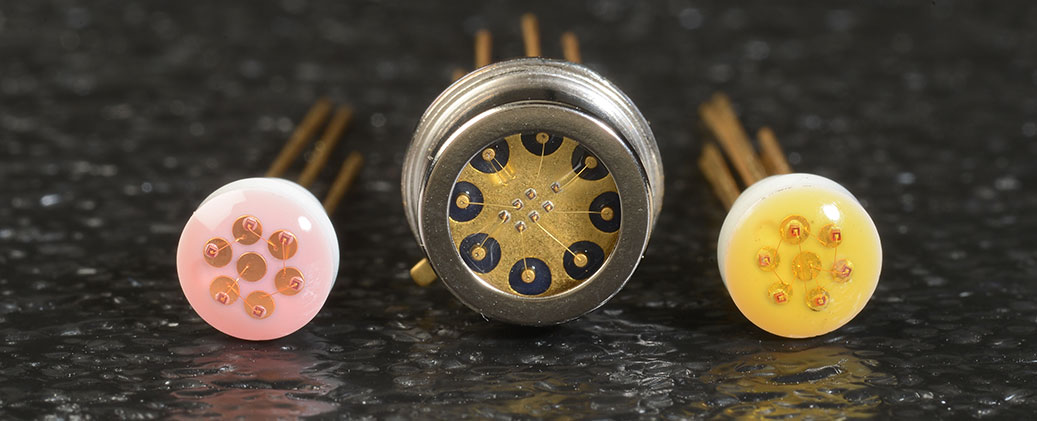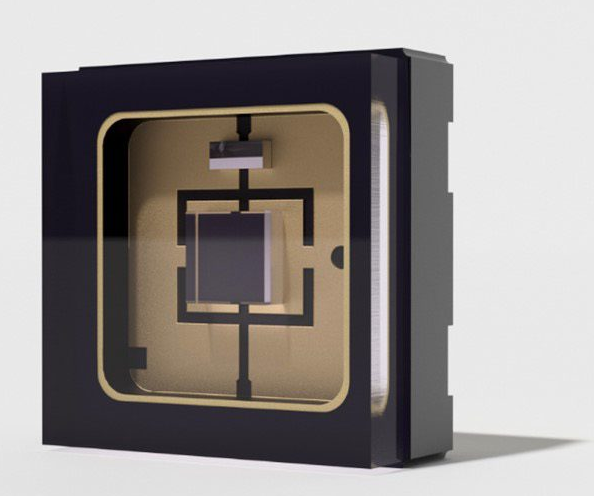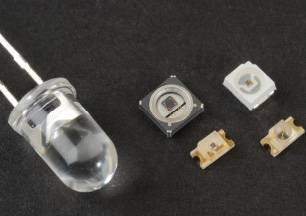Marktech’s Next Gen Hermetic SMD ATLAS Packaged InGaAs Detectors

Marktech MTMD34679PD6T38 – SWIR multi-chip emitter-detector with multiple wavelength LEDs
April 23, 2024 – Latham, NY, USA – Marktech Optoelectronics, Inc. (www.marktechopto.com)(Marktech), a privately-held leading designer and manufacturer of standard and custom optoelectronics, including UV, visible, near-infrared (NIR), and short-wavelength infrared (SWIR) emitters, detectors, InP epi wafers, and other compound semiconductors, today reveals their new multi-chip packages combining InGaAs photodiodes and multiple SWIR LEDs in the same package. These products join a growing line of multi-chip products consisting of multi-wavelength LEDs (UV through MWIR) with or without InGaAs, silicon, or InGaAs+silicon detectors.
Our range of multi-chip products includes:
- Multiple LEDs in a single package (235nm to 4300nm wavelength combinations)
- Multiple detectors in a single package (multiple silicon, InGaAs, and SiC photodiodes)
- Multiple LEDs + single or various detectors in a single package
- Packaging options include SMD, TO-can, and our award-winning ATLAS hermetic SMD

ATLAS hermetic SMD packages are ideal for LED, detector, & multichip applications.
Co-Packaged InGaAs Photodiodes with Multiple LED Emitters
Our newest multi-SWIR LED emitters + detector components include part numbers MTMD1479PD6T38 and MTMD34679PD6T38. MTMD1479PD6T38 includes 1460nm, 1720nm, and 1900nm SWIR LED chips combined with a 2.6µm InGaAs detector providing 800nm to 2600nm responsivity. MTMD34679PD6T38 has the same 2.6µm InGaAs detector co-packaged with 1300nm, 1460nm, 1650nm, 1720nm, and 1900nm SWIR LEDs. To the best of our knowledge, our 2.6µm InGaAs detector has the highest responsivity on the market based on our internal tests and customer evaluations comparing our InGaAs detectors with our competitor’s products.
Marktech’s UV, visible, NIR, and SWIR emitters combined with our IR detectors (InGaAs photodiodes) are the perfect solution for many analytical, medical, aerospace, and industrial sensing applications. An additional silicon detector can be added to the package when UV LED light needs to be monitored or detected. The co-packaged emitters are individually addressable. Multiple chip products are available in TO can and SMD packages.
Multiple Wavelength Multi-chip Products
For applications such as transmission spectroscopy requiring a multiple-wavelength source separate from the detector, Marktech also produces multi-wavelength -devices consisting of multiple LED chips in a single package.
Our newer LED light sources, Multiple wavelength LED emitters, have several advantages over singularly packaged LEDs and older, conventional light sources. Co-packaging multiple LED emitters can:
- Ability to rapidly vary light power output and wavelength
- Reduce Circuitry & Simpler Design
- Reduce Part Count
- More compact design – ideal for wearable applications
- High-speed wavelength selection
- No or minimal heat dissipation – reduce heat compared to halogen, xenon, mercury vapor, or thermal IR emitters
- Reduce power compared to halogen, xenon, mercury vapor, or thermal IR emitters
- Increase life compared to halogen, xenon, mercury vapor, or thermal IR emitters
- Fast response (on/off or pulsing) – no warm-up delay of halogen, xenon, mercury vapor, or thermal IR emitters
- Elimination of moving parts – e.g., motorized slit in dispersive spectrometers
- High emission stability – no or minimal wavelength drift over the lifetime
Our multiple LED and multi-detector products are available in several variations:
- Multiple emitters combined with InGaAs photodiodes for Vis-NIR-SWIR detection
- Multiple UVC LEDs (235nm, 255nm) with SiC photodiodes for deep UVC emission and detection
- Multiple emitters joined with silicon photodiodes for UVB-Vis-NIR emission and detection
- Multiple emitters sharing the same package with both InGaAs and silicon photodiodes for UVB-Vis-NIR-SWIR detection
- Multiple InGaAs, silicon, and InGaAs-silicon detector combinations with different emission filters on each photodiode
- Multiple InGaAs, silicon, and InGaAs-silicon detector combinations with integral transimpedance amplifiers (TIAs)
- Multiple InGaAs, silicon, and InGaAs-silicon detector combinations with thermionic coolers
- Multiple LED emitters of multiple wavelengths
- Multiple LED emitters of the same wavelength for increased power
Multiple emitters in one package ( up to 7 in our standard thru-hole or SMT package) along with detectors in a separate package (4, 5, & 6) can be helpful in colorimeter and color photometer applications using cuvettes where the excitation light is transmitted through the sample – or, where the excitation wavelength(s) needs to separate from the photodiode detector(s).
The specific combinations of emitters and detectors can be tailored or “mixed and matched” to your application’s specific light source and detection requirements.
In applications requiring higher power, multiple LED die of the same wavelength are placed in the same package. For example, Marktech’s MTMD4270T38 product contains two 428nm LEDs and two 700nm LEDs. Our MTMS1300N24 SWIR LED emitter contains three 1300nm chips in a narrow domed lens TO-can package. Our MTMD7885T38 multiple wavelength emitter has three 770nm die in a PLCC package. Our MTMS7700T38 (770nm), MTMS8800T38 (880nm), and MTMS9400T38 (950nm) products utilize six LED emitter chips in the TO-can package.

Examples of Marktech’s multiple wavelength, multi-chip LED products
InGaAs detectors and InGaAs photodiodes with multiple LEDs are beneficial in a variety of applications, such as:
- Biomedical instrumentation
- Black ice detection
- Broadband, hyperspectral, and multispectral light sources
- Colorimetry
- Contamination or foreign material detection
- Counterfeit currency detection
- Curing / Crosslinking
- Endoscopic lighting and tissue oximetry
- Fluorometry
- Fluorescence microscopy
- Functional near-infrared spectroscopy (fNIRS)
- FURA / calcium imaging
- Glucose monitoring
- Industrial machine vision
- Iris matching or recognition for biometrics
- NIR spectrometry
- Optical communications
- Optogenetics
- Oximetry / Co-oximetry
- Photodynamic therapy
- Photometry
- Solar simulation
- Sorting equipment
- Spectroscopy
- SWIR Detection
- SWIR Imaging
In some applications, the integral detector acts as a monitor to indicate the LEDs are emitting light. In other cases, the InGaAs can detect reflected or fluorescence emission from a sample illuminated by the LEDs. For example, oximeters, NDIR, and fNIR devices can emit and detect the reflected or partially transmitted light to determine oxygen levels in the tissue. For applications that require light transmitted through a sample and then detected, Marktech can package the LEDs and InGaAs detectors separately.
In dispersive spectroscopic analysis, a monochromator generates a wide range of wavelengths. Monochromators employ a prism or diffraction grating combined with a motorized slit to select a specific excitation wavelength. Typically, we look at the peaks of an unknown chemical or material analyte and compare them to libraries of identified reference spectra.
In specific applications with unknown amounts of known analytes in a closed system, only a few specific wavelengths are required to distinguish between and quantify particular chemical constituents. Examples of applications where a selection of specific wavelengths is helpful in chemical analyte quantification include:
- Spectroscopically analyzing the amount of reactant in a chemical production process
- Colorimetric analysis of process, drinking, or wastewater contaminants
- Oximetry, optical glucose monitoring, ischemia detection, and other medical diagnostics
- Fluorometry for fluorescence identification of minerals or biological materials
- Fluorescence microscopy for life science imaging (cells, proteins, biological materials)
- Non-dispersive infrared (NDIR) spectroscopy-based gas analyzers or gas sensors
In one of these “closed systems” with multiple analytes, sometimes the more efficient option is not to choose wavelengths corresponding to the peaks of the analytes but rather a few wavelengths producing the most significant differences between the analyte’s absorption, reflectance, transmission, or fluorescence. With this methodology, fewer LED emitters can often provide better analytical results. In addition, the ratio transmission results from two or more wavelengths can account for slight interference in turbid or dirty samples.

Drawing of MTMD34679PD6T38 2.6µm InGaAs detector multiple wavelength LEDs
Multiple LEDs in Spectrometry, Fluorimetry & Fluorescent Microscopy
Eliminating the monochromator combined with LED emitters’ higher natural monochromatic nature can produce a higher power excitation light source than a dispersion spectrometer with broadband xenon, halogen, and mercury sources. In dispersion spectrometers, conventional light sources are broken into 128 or 256 wavelengths, with each wavelength having only a fraction of the energy of the source. Higher-power LEDs at specific peak wavelengths can improve the signal-to-noise ratio.
When comparing or discerning two analytes, specific wavelengths provide no additional information when the absorption levels of the two species are equivalent. Therefore, eliminating these wavelengths and using a few critical discerning wavelengths can speed up the overall detection process.
In addition, since a handful of the target excitation wavelengths are picked, each wavelength source can be optimized for high power output and increased wavelength monochromaticity. For instance, additional LEDs with the same wavelength can be packaged in the same TO can, PLCC, or SMD package to provide higher power for a particular wavelength. In addition, Marktech can sort or bin LED emitters to produce tuned LEDs with minimal peak wavelength variation of ±1nm. In higher-volume applications, wavelength variation and power output can be adjusted at the wafer level or in the light-emitting diode fabrication process. Likewise, InGaAs and silicon detectors can be customized during semiconductor fabrication to specific sensitivity ranges – when production volumes warrant the development.
Fluorometers (fluorescence spectrometers) and microscopes utilize a specific excitation wavelength capable of exciting a fluorescent dye or fluorophore in a sample, emitting at a peak emission wavelength. Cells, tissues, and other biological samples are often examined with fluorescence. LEDs eliminate several problems in fluorescence studies compared to older light sources, such as overexposure to light, thermal damage and phototoxicity of the biological sample, and photobleaching of fluorescent dyes or proteins. The peak wavelength of the LEDs can be selected to match the excitation wavelengths of the fluorophores closely. Combined with the higher intensity or power output at the peak wavelength, the result is improved signal-to-noise in fluorometry and fluorescence microscopy applications. Our multi-wavelength LED packages enable the selection of a different excitation wavelength for different fluorophores, fluorescent dyes, or color-indicating reagents. For instance, our MTMD2336T38 multi-wavelength light source can selectively emit 275nm, 310nm, 360nm, and 380nm wavelengths, and our MTMD3334T38 multi-wavelength light source can selectively emit 310nm, 360nm, 380nm, and 430nm wavelengths.
NIR and incredibly SWIR wavelength light can penetrate deeper into human tissue than visible light due to the reduced photon scattering at these wavelengths. SWIR’s high penetration depth enables imaging and spectral information collection deep into tissues. Some of these NIR/SWIR infrared imaging systems have mapped blood flow in live animals and imaged tissue 5mm into mouse brains. In addition, infrared spectroscopy can provide information on deep tissue chemical composition, such as oxygenation and deoxygenation. In the article, “Shortwave infrared fluorescence imaging with the clinically approved near-infrared dye indocyanine green,” the researchers stated that “imaging in the shortwave IR (SWIR; 1,000–2,000 nm) promises higher contrast, sensitivity, and penetration depths compared with conventional visible and near-IR (NIR) fluorescence imaging.” The researchers used NIR and SWIR light sources with an InGaAs detector. Marktech has many singular and multi-wavelength LED emitters in the NIR and SWIR wavelength ranges. For example, the Marktech MTMD142345PDT38 multiple SWIR wavelength emitter-detector contains 1040nm, 1200nm, 1300nm, 1460nm, and 1550nm peak wavelength LEDs combined with our InGaAs photodiode for SWIR detection in the 600nm – 1750nm range. These SWIR emitter-detectors can be helpful in tissue oxygenation and utilization studies using NIRS methods.
In summary, spectrometry, fluorescence microscopy, and other optical analytical methods performed with a specific set of multiple LED light sources and the appropriate photodiode detector can have improved signal-to-noise ratio and detection speed.

Consult with Us Today About Your Design Project
Marktech Optoelectronics has vertically integrated capabilities for custom design and fabrication of InGaAs photodiode detector devices on wafers and fabless capabilities in silicon and silicon carbide. After fabrication, we dice and package these photodiode chips with the required LED emitters, amplifiers, filters, and other hybridization components for specific applications. This vertical integration allows Marktech to precisely control the performance and quality of the photodetectors and assemblies designed and manufactured for our customers.
Using Marktech Optoelectronics advanced silicon and InGaAs photodetectors in new products under development will likely lead to breakthrough designs in many analytical instruments, medical diagnostics, and industrial sensing applications.
If you have specific technical or application questions regarding your optoelectronics design project or are just interested in learning more about Marktech’s silicon, SiC, and InGaAs photodiodes with multiple wavelength LED emitters, then please reach out to us through the following:
- Contact our application engineers: [email protected]
- Request for information (RFI) or request for quote (RFQ) form: Contact Us
- For major photodiode engineering projects, contact:
Vince Forte, Chief Technology Officer, [email protected]
Barry Jones, Business Unit Manager [email protected]










